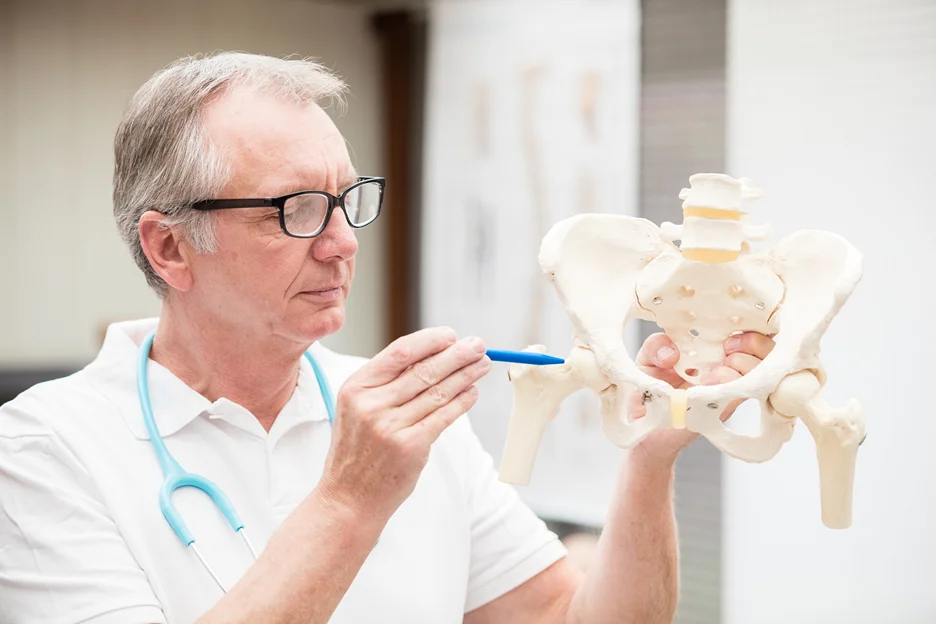Discover How Rebalancing Your Pelvis Alignment Could Be the Key to Sciatica Relief
Sciatica can be an extremely painful and debilitating condition.
It can make even simple movements like standing up or walking across a room agonizing. If you’re one of the millions of adults dealing with chronic back pain and sciatica, you know just how much it can diminish your quality of life.
But here’s some information you may not know – an uneven lateral pelvic tilt could be making your sciatica significantly worse.
At Kaly, we know first-hand how grueling it is to live with chronic back pain day after day. We’ve made it our mission to empower back pain sufferers by arming them with the knowledge to take control of their condition.
What Causes Your Pelvis to Tilt Sideways?

A lateral pelvic tilt refers to when your pelvic crests become uneven, causing one side of your pelvis to sit higher than the other. Your pelvis is the foundation of your core, so when it shifts out of alignment, it places strain on your lower back and can alter your posture. But what causes the pelvis to become crooked in the first place? Here are some of the most common culprits:
Why Does My Pelvis Tilt to the Side?
- Muscular imbalances
- Leg length discrepancies
- Previous injuries
- Conditions like scoliosis
- Poor posture over time
How Do Everyday Activities Cause Lateral Pelvic Tilt?
- Carrying your purse or bag on the same shoulder every day
- Sitting with your wallet in your back pocket
- Crossing the same leg consistently
- Sleeping in a rotated position or on your side
The effects of these daily activities and postures add up over the years resulting in a pronounced lateral pelvic tilt.
Can Lateral Pelvic Tilt Cause Sciatica?
Absolutely. When your pelvis tilts sideways from muscular imbalances, it changes the alignment of your lower spine. This places abnormal pressure on the lumbar vertebrae and can compress the sciatic nerve as it branches from your lower back through your hips and down your legs.
The irritation and inflammation of the sciatic nerve caused by lateral pelvic tilt is one of the primary causes of sciatica pain.
How Does a Tilted Pelvis Contribute to Sciatic Nerve Pain?
When the pelvis tilts, it causes the spine to curve abnormally, reducing space between the vertebrae. It also creates muscle imbalances since muscles on one side have to lengthen while muscles on the other side become shortened and tightened. This warps the spaces between muscles surrounding the sciatic nerve, putting pressure on it.
Specifically, a lateral pelvic tilt can compress or aggravate the piriformis muscle located deep in the buttocks. This muscle spasms and irritates the sciatic nerve which passes directly beneath it, leading to sciatic pain down the leg.
Addressing the underlying pelvic tilt can relieve the pressure on the piriformis and sciatic nerve.
What Symptoms May I Notice from a Lateral Pelvic Tilt?
There are a few telltale signs that point to a lateral pelvic tilt:
- Lower back pain concentrated more on one side
- Hip, buttock, or leg pain primarily on one side
- Muscle tightness only on one side of your lower body
- Uneven waistline, with one hip sitting higher
- Clothing fitting differently on each side
- One leg feeling longer than the other when standing
- Differences in range of motion between sides
How Can I Tell if My Sciatica is Related to Pelvic Tilt?
Sciatica resulting from a pelvic imbalance often presents with very specific patterns:
- Sciatic and back pain focused on just one side of your body
- Pain and tightness in the piriformis muscle of the tilted side
- Sciatica symptoms worsening with activity and prolonged positions
- Difficulty standing upright with both feet flat on the floor
- Leg length discrepancy with one leg unable to fully straighten
Consulting a specialist for a postural assessment can diagnose lateral pelvic tilt and its impact on sciatica. But even just observing your own body for asymmetry and one-sided pain patterns can indicate if pelvic tilt is a factor.
How Can My Doctor Confirm It’s Lateral Pelvic Tilt Causing Sciatica?

If you suspect a lateral pelvic tilt is behind your chronic sciatica pain, visit a spine specialist for an evaluation. Here are some assessments they may conduct to reach an accurate diagnosis:
| Assessment Type | Description |
| Postural assessment | Checking for pelvic asymmetry from the front, back, and sides. |
| Leg length tests | Comparing leg lengths lying down vs standing to determine true vs functional discrepancy. |
| Muscle testing | Assessing for strength imbalances and hypertonicity. |
| Chiropractic adjustments | Gentle maneuvers to check range of motion and alignments. |
| Imaging | X-rays to visualize spinal alignment and rule out other causes. |
| Nerve tests | EMG/NCV studies check for nerve damage and pinched nerves. |
What Specialists Can Help Diagnose and Treat Lateral Pelvic Tilt Sciatica?
If you don’t already have a pain management team, these are some of the experts who can assess and correct pelvic tilt sciatica:
| Expert Type | Role |
| Orthopedic Surgeon | Diagnose musculoskeletal issues and perform surgery if needed. |
| Chiropractor | Adjusts spinal alignment and reduces nerve impingement. |
| Physiotherapist | Prescribes therapeutic exercises to rebalance muscles. |
| Osteopath | Uses manipulative techniques to improve function and mobility. |
| Massage Therapist | Releases tight muscle tissues through massage. |
| Alexander Technique Practitioner | Reeducates posture and movement patterns. |
How Can I Find Relief from Pelvic Tilt Sciatica?

The good news is that with proper diagnosis and targeted treatment, pelvic tilt sciatica can be improved and effectively managed. Below are some of the top ways to find relief:
What are the Best Treatment Approaches for Long-Term Improvement?
- Physical therapy – Stretches, exercises, and modalities to rebalance muscles
- Chiropractic – Spinal adjustments to improve alignment and mobilize joints
- Lifestyle modifications – Adopting better posture, positions, and ergonomics
- Custom stretching/strengthening routines – Adding and releasing tension in key areas
- Massage therapy – Myofascial and trigger point release for tense muscles
- Pain management – Anti-inflammatory medication, nerve flossing, pain psychology
- Orthotics – Shoe inserts or wedges to stabilize pelvic positioning
- Pain relief tools – TENS, infrared heat, percussion massagers, supports
The most effective approach involves a multifaceted treatment plan tailored to your individual situation and adjusted over time. Having a coordinated team of providers is key to address both the symptoms and root causes.
While lateral pelvic tilt can certainly exacerbate debilitating sciatica pain, know that there are solutions available to realign your posture, alleviate nerve compression, and restore function.
With some diligence and expert guidance, you can take control of your pain and overcome the obstacles it has put in your life.
Kaly Can Help You
At Kaly, we believe that living pain-free is possible. As your partner in building a customized and comprehensive treatment plan, we’re here to provide the empowering information, tools, and support you need to improve your health. You are not alone on this journey – together, we will find the path forward.
